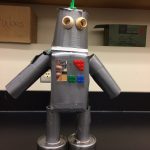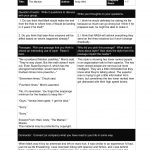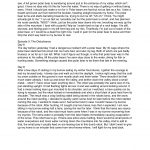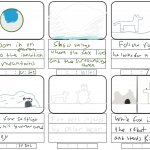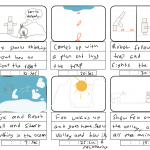Hello,
In this post I’m going to be talking about one massive project, which has many different parts and aspects to it. The project is our Frankenstuffie videos and stories. This project ties into our math, geography, textiles and ecology units. It’s a big project. So here it all is, explained:
In math class we made the villains of our soon-coming videos, called Math Monsters. We made them in math because after we built them, we needed to find the volume and surface area of their bodies. Here is a picture of mine:
Next, we read the award winning book The Martian by Andy Weir in Humanities because we were looking at the question: “Who is in control, the environment or humans?” This is the main question of the unit. While reading the book, every quarter of the way through, we filled out a section response sheet with questions. Here is an example of one of mine:
- Page 1
- Page 2
In our other humanities class, we learned about geography. We learned about maps and the differences between different areas of the world, like climate, weather, and land shape. Then we all chose a section of Canada for our video setting. Mine was the north Innuition Mountains. It’s in Northern Canada, and is part of the arctic. After we knew our setting, we needed to pick an animal that lived there. I chose the arctic fox. Then after a bit of research we made a small storyboard for an epistolary story we would write on this. Then we started writing. An epistolary story is where the characters tell the story in a log book or diary type format. This is exactly like the way the Martian was written.
I’d better explain how our stories were supposed to be written:
Our Frankenstuffie, called that because it would be an animal that adapts to its surroundings in a crazy way, needs to be dropped into a new environment where it starts a new life. The environment needs to be explained, the life in it, the setting, and the way it works. Then our math monsters need to come into the story and cause a disturbance in the environment the Frankenstuffie is living in. The Frankenstuffie needs to adapt to the change or problem is some way that will boost its survival chances in the story. Then the Frankenstuffie needs to battle the monster, and after everything we needed to explain how the environment is restored, and or changed in a good or bad way.
The whole story needs to be 8 episodes long, and each episode 200-500 words.
So, without further ado here is my epistolary story:
- Page 1
- Page 2
- Page 3
- Page 4
- Page 5
- Page 6
I really enjoyed the writing of those stories, I didn’t realize how much I liked writing. I loved being able to make my own story, using my imagination and writing skills to create a fun, entertaining story.
After that, the textiles part comes into play. We all got a number of stuffed animals to create our Frankenstuffies with. I got myself a fox from home, and a seal from the dollar store. Here are the originals:
The next thing we needed to do was to make our animals with their adaptations by sewing pieces of one animal onto another. So, I cut off the tail and front fins of my seal, and sewed them onto the fox. This was so that the fox could swim and breathe under water just like in my epistolary story. Here’s a clip of me and my amazing sewing skills:
https://youtu.be/uT_-7PIty28
And here is a picture of the end product:
The seal flippers are attached to the front paws of the fox, and the seal tail right below the fox tail. Well, now that that is done, I needed to move onto the next part.
Now the next part to the story will be to make our videos. So, we drew out a storyboard before we started filming to get prepared and our ideas down. This is mine:
- Page 1
- Page 2
It’s a very rough sketch and our videos don’t have to follow it exactly. The main point to this was just to have a general idea in mind so we don’t waste time in the filming process. Now, the video didn’t have to be our whole epistolary story thankfully, we could choose any point of the story to use, as long as it makes sense to a new viewer that didn’t read the story. I chose to start after fox adapts into a fox/seal hybrid, and just before the robot comes. Then I continue to the end of the story, but not as much detail as the written story. So basically the last third of the story. I mainly used the app Explain Everything, because it was the easiest way to make the video, since I couldn’t go out to the arctic to film live, I had to animate my video. I used the app Photoshop Mix to edit my photos and take away the unnecessary backgrounds of my animal images. It’s a great photoshop app, very easy to use. Those were the two main apps I used, but I also used the Internet for copyright free images for backgrounds and other stuff. So after all the other projects vital to this video, here is my Frankenstuffie Video:
I spent a lot of time on this video, most to make it a good video, and some just because it actually does take a lot of time. After probably 4.5 hours of just the video making process, I have that video to show for it. And I am proud of it. It shows the story of my animal, explains its adaptations, introduces the monster, shows the battle, and how the environment is restored all in just under 4 minutes.
This whole entire “unit” I should call it since it’s so big, has taught me lots, directly, like studying for ecology tests for science, and indirectly, like having to incorporate ecological and environmental information into my epistolary story and video. Overall, I enjoyed the build up to one big finale where all we have learned is showcased in a video we created ourselves.
